Jazz Australia '96
by Antonio J. García
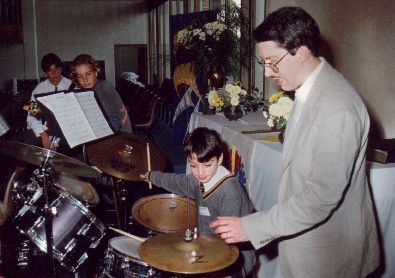 |
William gets a drum set lesson from Antonio García at Christchurch Grammar School in Perth as Josh and Haslett look on. Photo credit: Graham Nielsen, Christchurch |
At the invitation of Patrick Crichton, the IAJE Executive Board's Australasia Representative, I had the honor and pleasure of teaching and performing in Australia for several weeks this past June and July. A related article ("Fostering Jazz Education In Rural Australia," by Susan McLean) has focused on the first site of my visit, the town of Euroa. I continue here with a look at the two weeks that followed in Western Australia, site of the 1996 IAJE Jazz Australia conference.
Euroa
A year and a half of planning–most accomplished by e-mail–had finally brought me to Australia, where I began a pre-conference residency. The opportunity to meet and work with the students and teachers of Euroa was a remarkable one: in the rural area some 2000 miles away from the nearest large city lay a community offering its students a nurturing experience in jazz beyond what some American students receive. The concert band of Euroa Secondary College (students of elementary-school age) was exploring an arrangement of Thelonious Monk's "Round Midnight." Dozens of students from Euroa and Goulburn Valley came together to participate in jazz workshops. And student jazz, funk, and fusion bands peppered the school and later the Euroa Community Arts Centre with excitement. It was my privilege to perform as a trombonist and scat-singer with a combo of terrific jazz musicians who reside in Melbourne: pianist Adam Novakovic, bassist Matt Clohesey, drummer Edward York, and alto saxophonist Tim Wilson (the new jazz instructor at the College).
The fact that Euroa's program is vital and challenging, that its students are growing ever more expressive, is a tribute to everyone in this geographically rather isolated community. It takes tremendous effort to create innovation, especially when resources are not abundantly available. The ongoing leadership of Arts Coordinator Susan McLean, the energy of Musical Director Peter Garla (who performed as vocalist with a combo of Euroa students and alumni), and the inspirational musicianship of Tim Wilson have formed a jazz link with their students, fellow faculty, and the community at large.
Jazz Australia
Formed in 1992 as a venue to provide "the best possible value to teachers, young musicians, and the general public," Jazz Australia is an annual event with IAJE and the Western Australian Academy of Performing Arts (Edith Cowan University) as its co-hosts. Professor Pat Crichton (W.A. Conservatorium of Music Jazz Director) serves as Artistic Director of JA, overseeing this conference that has over the years brought Australian jazz artists such as Graeme Lyall, Dale Barlow (reeds); James Morrison (trumpet/trombone); Tony Gould, Roger Frampton (piano); Doug deVries (guitar); and the "Free Spirits" ensemble of Sydney together with American artists such as Thom Mason, Willie Hill (woodwinds); Bobby Shew (trumpet); Carmen Lundy (vocals); David Garfield (piano); John Clayton, Rufus Reid (bass); and Akira Tana (drums). For the 1996 event, trumpeter Jeff Jarvis and I represented the United States, partnering with Australian drummer Darryn Farrugia to participate in the whirlwind of educational activity that Jazz Australia creates: clinics, concerts, and trade exhibits.
In any comparison to similar U.S. events, one notices a certain weight of larger importance placed on JA than American culture might impart. At the formal opening of the conference, the Minister of the Education Department of Western Australia–not of music education, but of all education–spoke publicly regarding the musical and personal growth afforded Australian youth via the study of music, specifically jazz. And two unique but longtime sponsors of JA are the organizations Quit–from the Health Department of W.A.–and Healthway, both which recognize the physical and mental health benefits of performing music and encourage the students involved to stay in shape and avoid smoking. While it may be difficult to imagine a United States Cabinet member offering verbal or financial support to jazz education at a festival in this way, Australia's example provides inspiration.
Such an event needs substantial sponsorship to succeed: answering the call for funding along with IAJE, the Western Australian Academy of Performing Arts, Quit, and Healthway were the Lotteries Commission, Green World Indoor Gardens, Drum Workshop, Yamaha (which sponsored Farrugia), Kendor Music and Boosey & Hawkes (sponsoring Jarvis), and Northwestern University and Selmer (sponsoring me).
Crichton enlisted the year-long assistance of Arts Administration student Fred Block as JA Convener to coordinate much of the fine detail of conference planning. In another move differing from many other conferences, they surveyed via questionnaire previous and prospective JA participants–educators and students–during the planning stages for the '96 event. The feedback received motivated Crichton to restructure JA from an event which had formerly required participants to visit the Conservatorium for all sessions, now transforming it into a moving caravan of clinicians who traversed Western Australia in order to assist school music programs in their own familiar, local environment for two-hour sessions. Thus the theme of this year's JA was "Addressing the Needs." Students and educators found themselves at ease, without the strains of cross-country travel and unknown locales. And I found a variety of ensemble instrumentations awaiting me, all sharing an interest in jazz and jazz-influenced music.
On the Road
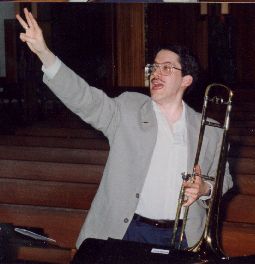 |
Conducting and demonstrating went hand in hand throughout clinic sessions in Jazz Australia. Photo credit: Christchurch Grammar School |
After a welcoming Sunday night dinner in Perth, I began week one of Jazz Australia. While most trips were by car, one day did offer a greater geographical challenge: flying north early in the morning via small plane to a rural area where I worked with ensembles from three schools before flying back that night. Wherever I traveled, the students, directors, and I focused on the aspects of the music most in need of attention–issues common to jazz education around the world (see sidebar). Over the eight-day site visits I left a selection of various listening lists, ensemble and soloing tips, and curricular suggestions for the teachers and their students. This was not to be a one-way street, as days yet to come at the W.A. Conservatorium were to provide excellent opportunities for the exchange of ideas–including with some of the very same faculty I had been privileged to visit in the field.
I often asked youngsters who their favorite musician was on their instrument; and as in the U.S., many cannot name one–in any genre, much less jazz. They sensed this was a concern; and I told them that when I was asked this question at their age, I pointed to the kid next to me! Comparing that scenario to one in which students who had never seen a tree would then be asked to draw one in art class, I made clear to the young musicians that they must hear jazz to pursue it. I invited them to attend some of the upcoming live JA concerts of ensemble, solo, and vocal jazz: the entire forest of trees would then become much clearer.
Unique Opportunities
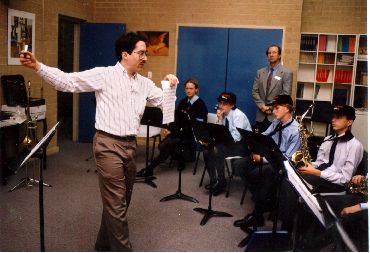 |
Working with the students at All Saints College in Bullcreek. Photo credit: Jazz Australia |
Relatively few programs anywhere seem to provide improvisational experience for players of all instruments such as I encountered at All Saints College in Bullcreek. These high school-age students benefit from the instruction of Kevin Fenner, a professional jazz saxophonist who clearly succeeds in transmitting his experience in the academic setting. As I looked at this large combo–which included not only trumpet, alto sax, piano, and bass but also bari sax, violin, cello, and a student alternating between trombone and drum set–I heard the sounds of Monk's "Straight, No Chaser" and Parker's "Ornithology." Due to the oft-changing instrumentation of the group since he founded it in 1991, Mr. Fenner's arranging skills are required, providing fresh sounds for each player. The soloists demonstrated skill and individuality, especially Kathy on violin and Monica on piano.
Banksia Park Primary School in Leeming has a similarly notable program for students of younger ages. Their jazz band of sixth and seventh graders is directed by Phil Arnold, who is faced with an annual challenge unfamiliar to many teachers: half his students are new to the ensemble–and half have one year of experience and will graduate from the band at the end of the year. As these students grooved through swing and shuffle charts, they proved that they learn more in a year or two than most their age; and they were eager to hear suggestions for additional improvement. The lead alto saxophonist was a fine soloist; and I led the entire ensemble in singing along with Miles Davis' solo on "So What" in order to learn from a jazz master. When I pointed out that they could "take a private lesson" from great jazz soloists via their recordings, drummer Naomi piped up that she was already singing along with recorded solos.As with Fenner, Arnold is a performing jazz musician who is a part-time "specialist" in the school. I spoke to principals of various institutions who explained how it was necessary to defend annually the re-hiring of such one-year contract faculty despite their accomplishments–and even though the parents are often paying direct, extra tuition fees for their children's jazz instruction. It is a credit to all concerned that these programs remain, though I have since sent a dozen letters of support to school officials and boards in Australia to assist in the defense against any cutbacks in jazz education.
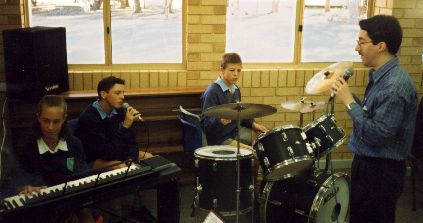 |
Tony leads a Strathalbyn student in trading fours of scat-singing. Photo credit: |
I chanced upon the opportunity to have lunch with some of Western Australia's most talented youngsters: the members of "Miles Ahead." This student-led combo is one of three jazz ensembles at "R.A. Jazz," a curriculum founded by Rob Anderson for the benefit of area students. The quality of these three groups–each of which I heard in performance–is a stellar example of what one's initiative can accomplish in jazz education. Pianist Niall Anderson (age 14) serves as leader of "Miles Ahead"; Alisdair Anderson (12) plays the drums; Christian Vardy (16) is bassist; and Paul Hadley (14) fronts the combo on the alto saxophone.
Our conversation centered on the list of musicians they regularly listen to–and their request to me for additional artists to seek out as inspiration. Their goal is clear to them, as reiterated by Hadley in a letter to me immediately after Jazz Australia: "'Miles Ahead' wants to be in the future great musicians and fine composers." Despite the height of this goal, the band members are modest, inquisitive, and respectful of the task ahead.
Jazz at the W.A. Conservatorium
The site of the second week of Jazz Australia, Edith Cowan University's W.A. Conservatorium of Music in Perth, offers a variety of jazz courses, including two undergraduate degree programs (Performance and Education). The Certificate in Jazz is apreparatory fundamentals course and includes principal instrument and secondary piano study, large and small ensemble experiences, jazz and classical history, plus theory, aural skills, and rhythm studies with a jazz focus.
Students enrolled in the Bachelor of Education (Music) degree in Jazz and the Associate Degree of Performing Arts in Jazz and Contemporary Music share the same core structure for the first two years with additional hours in the Certificate's topics above, plus studies in electronic music, composition and arranging, Alexander Technique, and arts management. The Bachelors students are expected to achieve a higher standard in order to pass on to year three, which then sees the Education majors concentrating on education and classical music studies, the Performing Arts majors continuing with jazz studies. (Courses at the Conservatorium are performance-oriented and include similar programs in classical music.)
Conservatorium Jazz Director Pat Crichton created the Advanced Certificate in Commercial Music to address the needs of those students with interests in songwriting/arranging, electronic music, sound engineering, and professional management skills–just a few of the course titles within this concentration. The curriculum for each of these four degrees is detailed extensively in "Unit Outlines" each student receives: the prerequisites, course material, listening and repertoire lists, reference texts, and testing of outcomes represent a concrete model of the Conservatorium's approach to teaching the abstract art of jazz.
Jazz Ensemble Festival
Opening at the Conservatorium the second week of Jazz Australia was the Western Australian Schools Jazz Ensemble Festival on June 30: eleven school ensembles ranging from primary to senior high-age gathered at the W.A. Academy to perform for an attentive audience and to receive constructive critiques from adjudicators Jeff Jarvis and myself. This festival was sponsored in part by the Australian Band and Orchestra Directors Association, an organization of over 400 directors; and many of the schools who had hosted a JA clinician during week one now traveled to the Academy to share each other's music.
The repertoire ranged from "Peter Gunn" and "Tequila" through "A Night in Tunisia" and "Afro Blue": music one might find at most high school jazz festivals around the world. Three vocalists–two from R.A. Jazz and one from Mount Lawley–performed with maturity; and the ensembles' renditions were solidly in the jazz tradition that had traveled so well across the Pacific.
If there were any uniquely Australian traits, one might be the conductors' count-offs to the tunes: often so quiet that I missed them entirely! As a visitor I would attribute this to the tremendously gracious and unassuming personalities of so very many of the Australian people I met: perhaps it seems too "showy" to offer a louder count-off. But for the benefit of those musicians playing in measure one, I suggested that at least a most-intense whisper in the groove of the tune would assist the secure start of the music.
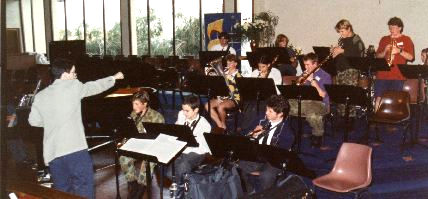 |
Rehearsing the band at Christchurch. Photo credit: Christchurch Grammar School |
Clinicians in the U.S. are used to asking the more boisterous drummers or bassists to lessen their volume in order to balance with the ensemble, and we have all heard the occasional over-blowing brass player or section. This was generally not the case in Australia: the young musicians offered balanced reserve and heartfelt playing–and sometimes received encouragement from the clinicians to "let loose" yet more.
Among the fine large ensembles heard were the Mount Lawley Senior High School Blues Band (directed by Brian Copping) and the Wesley Jazz Orchestra (directed by Geoffrey Lowe). Lawley's band, formed in 1992, has performed at several Australian jazz festivals and on national TV, touring to New Orleans in 1992. Its campus is ideally situated next to the Conservatorium for student exposure to artists visiting the University. Wesley's ensemble has been invited to perform at the Monterey Jazz Festival and the Asian International Musi c Festival (Singapore), making the rounds to several Australian sites.
WASJEF is non-competitive, with all ensembles receiving certificates of participation; but citations for outstanding musicianship were awarded to individuals from each school (see sidebar). When I later reflected on these young players as a group, I realized their comparatively young ages versus recipients of citations at similar festivals in the United States: this bodes well for the future of Australian jazz.
Youth Jazz Orchestras
Providing an unexpected delight during my visit was the Western Australian Youth Jazz Orchestra, a big band led by "Con" (Conservatorium) faculty member Graeme Lyall and comprised of area high school and university-age musicians. The band has performed at a variety of festivals and with Toshiko Akiyoshi, Red Rodney, Ronnie Scott, Phil Wilson, James Morrison, Don Burrows, and Andrew Firth. While I only heard the flagship group, "The WAYJO Association" has expanded to include two other ensembles, involving approximately sixty students in the pursuit of big band jazz.
It was my good fortune that Lyall had a schedule conflict with one evening's WAYJO rehearsal; so I was able to work with these outstanding talents and together explore the music of Thad Jones, Bob Brookmeyer, Sammy Nestico, Bob Mintzer, and others. The ensemble performed to close WASJEF with Jeff Jarvis as guest soloist, presented concerts and clinics within Jazz Australia week two, and performed its own independent engagements to great response.
JA Student Day
July 3 had been designated "Student Day" at Jazz Australia, and nearly one hundred people crowded into the front rows of the Academy Theatre to hear Pat Crichton's opening remarks. As the hours passed, students of primary through Conservatorium age participated actively in workshops and heard concerts by JA clinicians, area professionals, and their peers. Improvisation classes, master classes by instrument, and combo rehearsals dotted the day's schedule. Australian musicians Darryn Farrugia, Paul Pooley, Keith van Geyzel, Ray Walker, Graeme Lyall, Murray Wilkins, Andy Vance, and Roger Garrood lent their expertise to the visiting students and their teachers. Jarvis, Farrugia, and I each coached Con combo rehearsals, which were open for observation by other students and educators.
The Jazz West Big Band
In 1988 the Australian Bicentennial Authority commissioned a work ("Reflections of Western Australia 1788-1988") that became the reason for forming the Jazz West Big Band, which then toured in concert. The ensemble (including vocalist) provides a bridge between area jazz professionals–including Con faculty–and selected current students playing next to them. The band has performed repeatedly on ABC (Australian Broadcast Corporation) radio and with many artists-in-residence, also appearing at the prestigious Manly Jazz Festival. With the assistance of government and departmental grants Jazz West has recorded two CDs: one titled after the 1988 commission, the other Take the Light. These discs demonstrate not only the highest quality of solo and ensemble work but also the band's commitment to performing original works by Western Australian composers and arrangers.
Jeff Jarvis, Darryn Farrugia, and I had the pleasure of rehearsing with Jazz West on two of its usual Monday evenings, learning not only eight challenging and artistic Australian originals but also equally meaty charts brought in from Jeff's Kendor catalog. Our partnership culminated in a concert July 3 at the Academy Theatre, where the band ripped through a sixteen-chart program with a full range of expression, delighting the capacity crowd–including so many students "seeing the tree" for the first time. Band members provided just the right amount of explanatory remarks from the stage regarding the pieces, which were recorded for later broadcast on ABC radio.
At intermission and afterwards I repeatedly met students whose schools we had visited–and their parents, who expressed amazement at how inspired their children had become to pursue their own jazz music. "I didn't understand why my daughter took me out to buy these CDs by Miles Davis and Sonny Rollins...," described one parent, "...until I heard her singing along with their solos for hours. She'd come downstairs and exclaim, 'Mom, I can do it! I can do it!'"
JA Educator Days
Though the previous ten days had been filled with activities of benefit to all music educators, July 4 and 5 were dedicated to them. As a unique requirement for entry to the workshops, each attending educator submitted two specific, written questions; so topics were focused on elements of crucial interest. Sessions included:
• "New Music Reading Session" with WAYJO (Jeff Jarvis and local Lindsay Timms)
• "Teaching Improv with No Jazz Background" (Con alumnus Michael Cartwright)
• "Working with What You Get: Forming Small Groups and Writing Your Own Material" (Mt. Lawley SHS director Brian Copping)
• "Rhythm Section Workshop" (Pat Crichton, Jeff Jarvis, and Darryn Farrugia)
• "Getting the Most out of Combo and Band 'Packs'" (Lindsay Timms)
• "Percussion Master Class" (Darryn Farrugia)
• "Arranging and Composition" (Jeff Jarvis)
• "In Concert: Banksia Park Primary School Jazz Band" (Phil Arnold)
I assisted aspiring jazz vocalists in two sessions: one devoted to concrete means to "steal" from the jazz vocal masters, the other an opportunity for three vocalists each to sing, receive constructive critiques, and perform exploring those suggestions. Between these two sessions I coached a pair of WAYJO trombonists in jazz lessons.
In my final session, "Structuring Improv in Secondary School," educators requested ways to manage their students' fear of beginning improvisation. I provided a series of musical exercises for the Mount Lawley students on stage to perform that required them to play all the "wrong notes" and indeed had them laughing with delight as they learned to manipulate them.1 Conservatorium faculty jazz saxophonist Roger Garrood and I demonstrated that we each–on different sides of the Pacific–had come up with related yet different approaches to this challenge. I left each educator with a sheaf of reference handouts, including information regarding the then-anticipated IAJE/MENC jazz curriculum guide, Teaching Jazz: A Course of Study.2
IAJE Australasia Meeting
Jazz Australia concluded with an open meeting of the IAJE Australasia Section for all interested educators, with Section Coordinator Pat Crichton presiding. Jeff Jarvis stepped into his IAJE Executive Board role and I my Journal Editor and Unit President roles: we each shared our perspectives on what we had learned during our time in Australia and what we could offer as suggestions for the future.
Over the course of my two and one-half weeks overseas, a number of educators had shared with me an interesting difference between the Australian and American training for the music education degree: in Australia, there seems to be no requirement that future educators take conducting classes. Their training is based more on a model of English church music education: heavy emphasis on theory, little on ensemble practice. As a result, a majority of teachers I met described to me how their first experience formally leading an ensemble was on their first job, which must have been a tremendous pressure. Even more stated they had no exposure to jazz in their training–a situation far too common for American music education students as well.
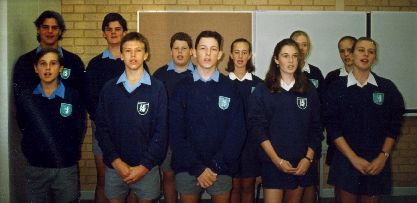 |
The Strathalbyn Christian College's contemporary christian choir in a workshop performance in Geraldton. Photo credit: |
The variety of ensembles was striking: it was obvious that directors and students did not allow the lack of a "standard" instrumentation to hamper their interest in playing jazz. In part, this seemed a by-product of the need to accept into one's program the most interested students, regardless of the end combination. Without the students' enthusiasm, these ensembles would not continue: virtually all the music (not just jazz) in the schools I that observed was extracurricular–held before or after school with no academic credit. The students' high level of interest in creating where often nothing existed recently before is impressive.
After reports and ideas from all corners, officers for the Australasia Region were slated and approved; and Jazz Australia was officially over.
Live at The Greenwich
But any fine event deserves an encore; so we "reconvened" at 10:15 p.m. the night of July 5 at "The Greenwich" in Perth for the first of two nights of small-group jazz. On this occasion I was honored to perform with an outstanding rhythm section of Jazz Australia friends. Pianist Andy Vance's acerbic wit–demonstrated on occasion at the microphone during the Jazz West Big Band concert and now on this night–was exceeded only by his ability to release his musical improvisations in a range breathlessly spanning from the lightest touch of a finger to the flailing elbows of a desperate muse. Fellow Conservatorium faculty member Murray Wilkins demonstrated his fleet lyricism on the bass, laying down melodies without apparent limitation and groove patterns that anchored all the music around him. And JA clinician Darryn Farrugia proved yet again his talent for sweeping effortlessly into the foreground and back, inciting responses with his drummed comments, answering the moment with whatever was required, and eliciting solos from his instrument as melodic as any other. It was a privilege for me to share two sets making music with them as I alternated between playing solos on trombone and scat-singing.
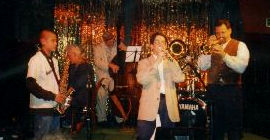 |
Australian student saxophonist Paul Hadley sits in with Tony García (tbn) and Jeff Jarvis (tpt) at The Greenwich in Perth. In the background is Andy Vance (pno), Murray Wilkins (bs), and Darryn Farrugia (dr). |
The capacity crowd was equally pleased, and the club owner grinned that he had never had a better night for business. To close the early morning set, I invited JA partner Jeff Jarvis (who would offer his own night of jazz there the next evening) to the stage to join in the last tune–as well as young alto saxophonist Paul Hadley, who has received several awards of merit from various Australian jazz festivals. Choosing the minor blues "Mr. P.C.," Paul explored and enjoyed his musical opportunity to the delight of the packed house. He later wrote, "That night which you let me play with you and Mr. Jarvis, I was buzzing. I have no words to express my feelings that night. It was great!" Sharing inspiration with the young Australian musicians throughout my visit was a great reward.
JA in Sum
Jazz Australia offered me a variety of opportunities I rarely encounter in such a brief span of time. In addition to the advance residency in Euroa (where I both taught and performed), I visited nine school programs in and outside of Perth–primary, secondary, and senior high school–directing and offering musical advice to student gospel choirs, string ensembles, concert bands, brass bands, jazz bands, and jazz combos pursuing the expression of jazz and jazz-influenced music. Adding that to the time spent at the Conservatorium, where I adjudicated and rehearsed high school jazz ensembles, coached Con combos, performed with the Jazz West Big Band (including one of my compositions) and with the combo at The Greenwich, led vocal and instrumental jazz master classes, and discussed pedagogical approaches with educator colleagues–one arrives at a menu that sought to make best use of any experience I was ready to offer. The only way to have expanded the palate of interaction further would have been to sample the nature of jazz education in Sydney, Melbourne, and other areas of this vast continent–for which time on this trip simply did not allow.
On most occasions when I travel to offer assistance to students and/or educators, I may not see them again for months or even years. Given the structure of Jazz Australia, however, I was uniquely able to visit students repeatedly: on their own campus one week, perhaps in concert a few days later, maybe in workshops or lessons at the Conservatorium after that, and talking with them and their parents in the hallways between events. JA gave me the chance to witness immediately the fruits of the seeds I had planted in my first meeting with various students.
Minds Over Matters
Perhaps the greatest lesson offered us all by the Jazz Australia conference is that the efforts of a relatively few persons can indeed make a profound difference. Some IAJE Units in the United States and elsewhere in the world face the challenges of low membership numbers and/or a considerable geographic distance between its members. Sometimes the uphill battle of creating momentum and growth seems insurmountable.
As Australia's largest state, Western Australia measures some 2.5 million square kilometers (about 1.5 million miles), into which could fit Texas, the United Kingdom, and Japan. Approximately 1.5 million people live in W.A., over a million of whom are residents of its capital, Perth. Yet the IAJE Australasia Section–whose seven regions divided by desert count only seventy members spread across all of Australia–have increased the spread of knowledge about jazz and jazz education in an exponential way.
Even fewer IAJE members, led by Pat Crichton, have created this force of learning that is Jazz Australia. Their mission is to inform music educators and their students across the continent–most of whom have never heard of IAJE–about the information and resources IAJE can offer them, to afford the students the very best opportunities to learn about and perform jazz, and to perpetuate the art form for the musicians and enthusiasts who have become as dedicated to it as anyone in its U.S. birthplace. Remember that what you've read here of my travels is but a third of the outreach visits to various school campuses, as JA clinicians Jarvis and Farrugia each fanned out to a comparable number of different sites (see sidebar).
It is my hope that this article will bring the Australasia Section to the attention of those around the world who can assist it further–and provide evidence for Australian communities, administrators, educators, and students that their achievements to date have been recognized (and indeed should be made part of the mainstream curriculum). Finally, the Australian IAJE members can circulate this edition of the Journal to non-member educators and students, inviting them to join IAJE and become its future.
Personally speaking, my wife and I have many heartfelt memories of the Australian people, who are so overwhelmingly kind and generous. It is easy to see why so many who visit hesitate to leave, and we thank our many new friends for their unending hospitality.
Anyone seeking information regarding the 1997 Jazz Australia conference or CDs of the Jazz West Big Band should contact Pat Crichton. Prospective IAJE members in the region may contact Pat or their area coordinators for details on joining. See the "IAJE Sections and Regions" page of this JEJ for addresses.
Footnotes
1 For further information on many of the pedagogical approaches referenced, see the author's improvisation articles "Thematic Dissonance–No Wrong Notes!" (IAJE Jazz Educators Journal, Spring 1991) and "Improve Your Improv–Not Just What You Say, But How You Say It" (Down Beat, September 1994), plus phrasing articles "Pedagogical Scat" (MENC Music Educators Journal, September 1990) and "Fine-Tuning Your Ensemble's Jazz Style" (MENC MEJ, February 1991).
2 See the author's article, "The IAJE Jazz Curriculum Guide: An IAJE/MENC Partnership" (IAJE Jazz Educators Journal, September 1996)
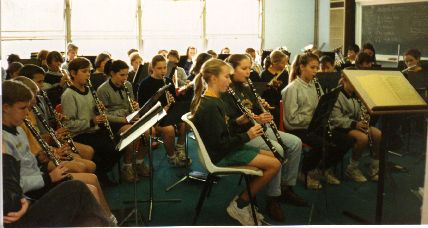 |
After developing their internal sense of the beat, the students of Sawyer's Valley Primary School's combined concert bands play through a blues arrangement without a conductor leading. |
Typical Topics of JA Site Visits1
Physical Readiness
*full-body exercises to open up one's sound
Solo & Ensemble Style
*time-keeping: without a conductor, with and without a metronome on 2 & 4 in swing to develop one's own, internal perception of the beat
*time feel: greater emphasis on beats two and four in gospel music, more subtlely so in swing; how the "clave" beat in Latin music should influence the interpretation of all ensemble members' parts
*mental concept: horn players singing the phrasing of lines to define their intent on their instruments
*articulation and phrasing: delivering swing and bop lines with added emphasis on the upbeat-eighths rather than the downbeats (in moderate tempos); blowing one airstream for a phrase rather than puffing breaths for each brief note
*source recordings for reference
Rhythm Section Style Specifics
*guitar: "Freddie Green" style
*piano: editing the written part
*bass: subtle emphasis on beats two and four in bass lines
*drums: balancing appropriately the sound generated by four limbs: steady ride cymbal, minimal bass drum in swing excepting accents, driving hi-hat, and a legato snare-drum concept that allows more effective "shots"
*for all players: the differences between swing and shuffle, appropriate amplification for a given style, and lining the beats up with the bass and ride cymbal to share the groove rather than dictate it from the drum set
*source recordings for reference
Improvisation
*call-and-response riffs
*comparing improvised speech with improvised music
*scat-singing along with recorded solos (especially Miles Davis)
*ad-lib scatting
*identifying the relatively few key centers represented by the many chord progressions in a given tune;
*chord/scale relationships
*source recordings for reference
Sound Reinforcement
*mic placement
*sound system equalization
1996 WASJEF Outstanding Musician Citations
Student (Age) Instrument Ensemble Di rector
Dave Aldersen (13) drums R.A. Jazz Swing Band No. 3 Rob Anderson
Germaine Salim (13) piano Hollywood Senior High School Swing Band Simon Treadwell
Ryan Wilson (17) trumpet John Forrest Senior High School Swing Band Glenn Robinson
Paul Hadley (14) alto saxophone Miles Ahead (R.A. Jazz) Niall Anderson
Tristan Cameron (14) trombone Wesley Junior Jazz Kieran Hurley
Kathy Potter (17) violin All Saints College Jazz Ensemble Kevin Fenner
Michael Cicanese (15) bass Kolbe Catholic College Swing Band Peter Legg
Christian Sayers (17) tenor saxophone Geraldton Senior High School Jazz Band Andrew Patrick
Matthew Hadfield (13) tenor saxophone R.A. Jazz Swing Band No. 2 Rob Anderson
Tane Tarrant (16) guitar Mount Lawley Senior High School Blues Band Brian Copping
Matthew Jodrell (15) trumpet Wesley College Jazz Orchestra Geoffrey Lowe
Participating Schools/Organizations, Jazz Australia 1996
School Locale (W.A.) Director Clinician
All Saints College Bullcreek Kevin Fenner Antonio García
Banksia Park Primary School Leeming Phil Arnold Antonio García
Busselton Senior High School Busselton Michael Webb Jeff Jarvis
Christchurch Grammar School Claremont Carmelia MacWilliams Antonio García/Darryn Farrugia
Churchlands Senior High School Churchlands Faye Carver Jeff Jarvis
Geraldton Senior High School Geraldton Andrew Patrick Antonio García
Guildford Grammar School Guildford Serge LeGoueff Jeff Jarvis
Hollywood Senior High School Hollywood Simon Treadwell (WASJEF only)
John Forrest Senior High School Morely Glenn Robinson Antonio García
Kelmscott Senior High School Kelmscott Michael Cartwright Jeff Jarvis
Kolbe Catholic College Rockingham Peter Legg/Phil Schipp Jeff Jarvis
Morawa District High School Morawa Dean Carslake Antonio García
Mount Lawley Senior High School Mount Lawley Brian Copping Jeff Jarvis
Prendiville Catholic College Ocean Reef Maureen Hampele Darryn Farrugia
Sacred Heart College Sorrento Fred Rooke Antonio García
Saint Brigid's College Lesmurdie Erica Cooga Darryn Farrugia
Sawyers Valley Primary School Sawyers Valley Margaret Fong Antonio García
Saint Hilda's College Peppermint Grove Andrew Raymond Jeff Jarvis
Strathalbyn Christian College Strathalbyn Samantha Leonardis Antonio García
Viveash La Salle (R.A. Jazz) Midland Rob Anderson Darryn Farrugia
Wesley College South Perth Geoffrey Lowe/Kieran Hurley Jeff Jarvis
Western Australian Youth Jazz Orchestra 1 Perth Gail Gargill, Manager Antonio García
Western Australian Youth Jazz Orchestra 2 Perth Gail Gargill, Manager Jeff Jarvis
Western Australian Youth Jazz Orchestra 3 Perth Gail Gargill, Manager Darryn Farrugia
_ _ _ _ _ _ _ _ _ _ _ _ _ _ _
Antonio J. García is a Professor Emeritus and former Director of Jazz Studies at Virginia Commonwealth University, where he directed the Jazz Orchestra I; instructed Applied Jazz Trombone, Small Jazz Ensemble, Jazz Pedagogy, Music Industry, and various jazz courses; founded a B.A. Music Business Emphasis (for which he initially served as Coordinator); and directed the Greater Richmond High School Jazz Band. An alumnus of the Eastman School of Music and of Loyola University of the South, he has received commissions for jazz, symphonic, chamber, film, and solo works—instrumental and vocal—including grants from Meet The Composer, The Commission Project, The Thelonious Monk Institute, and regional arts councils. His music has aired internationally and has been performed by such artists as Sheila Jordan, Arturo Sandoval, Jim Pugh, Denis DiBlasio, James Moody, and Nick Brignola. Composition/arrangement honors include IAJE (jazz band), ASCAP (orchestral), and Billboard Magazine (pop songwriting). His works have been published by Kjos Music, Hal Leonard, Kendor Music, Doug Beach Music, ejazzlines, Walrus, UNC Jazz Press, Three-Two Music Publications, Potenza Music, and his own garciamusic.com, with five recorded on CDs by Rob Parton’s JazzTech Big Band (Sea Breeze and ROPA JAZZ). His scores for independent films have screened across the U.S. and in Italy, Macedonia, Uganda, Australia, Colombia, India, Germany, Brazil, Hong Kong, Mexico, Israel, Taiwan, and the United Kingdom. He has fundraised $5.5 million in external gift pledges for the VCU Jazz Program, with hundreds of thousands of dollars already in hand.
A Bach/Selmer trombone clinician, Mr. García serves as the jazz clinician for The Conn-Selmer Institute. He has freelanced as trombonist, bass trombonist, or pianist with over 70 nationally renowned artists, including Ella Fitzgerald, George Shearing, Mel Tormé, Doc Severinsen, Louie Bellson, Dave Brubeck, and Phil Collins—and has performed at the Montreux, Nice, North Sea, Pori (Finland), New Orleans, and Chicago Jazz Festivals. He has produced recordings or broadcasts of such artists as Wynton Marsalis, Jim Pugh, Dave Taylor, Susannah McCorkle, Sir Roland Hanna, and the JazzTech Big Band and is the bass trombonist on Phil Collins’ CD “A Hot Night in Paris” (Atlantic) and DVD “Phil Collins: Finally...The First Farewell Tour” (Warner Music). An avid scat-singer, he has performed vocally with jazz bands, jazz choirs, and computer-generated sounds. He is also a member of the National Academy of Recording Arts & Sciences (NARAS). A New Orleans native, he also performed there with such local artists as Pete Fountain, Ronnie Kole, Irma Thomas, and Al Hirt.
Mr. García is a Research Faculty member at The University of KwaZulu-Natal (Durban, South Africa) and the Associate Jazz Editor of the International Trombone Association Journal. He has served as a Network Expert (for Improvisation Materials), President’s Advisory Council member, and Editorial Advisory Board member for the Jazz Education Network . His newest book, Jazz Improvisation: Practical Approaches to Grading (Meredith Music), explores avenues for creating structures that correspond to course objectives. His book Cutting the Changes: Jazz Improvisation via Key Centers (Kjos Music) offers musicians of all ages the opportunity to improvise over standard tunes using just their major scales. He is Co-Editor and Contributing Author of Teaching Jazz: A Course of Study (published by NAfME), authored a chapter within Rehearsing The Jazz Band and The Jazzer’s Cookbook (published by Meredith Music), and contributed to Peter Erskine and Dave Black’s The Musician's Lifeline (Alfred). Within the International Association for Jazz Education he served as Editor of the Jazz Education Journal, President of IAJE-IL, International Co-Chair for Curriculum and for Vocal/Instrumental Integration, and Chicago Host Coordinator for the 1997 Conference. He served on the Illinois Coalition for Music Education coordinating committee, worked with the Illinois and Chicago Public Schools to develop standards for multi-cultural music education, and received a curricular grant from the Council for Basic Education. He has also served as Director of IMEA’s All-State Jazz Choir and Combo and of similar ensembles outside of Illinois. He is the only individual to have directed all three genres of Illinois All-State jazz ensembles—combo, vocal jazz choir, and big band—and is the recipient of the Illinois Music Educators Association’s 2001 Distinguished Service Award.
Regarding Jazz Improvisation: Practical Approaches to Grading, Darius Brubeck says, "How one grades turns out to be a contentious philosophical problem with a surprisingly wide spectrum of responses. García has produced a lucidly written, probing, analytical, and ultimately practical resource for professional jazz educators, replete with valuable ideas, advice, and copious references." Jamey Aebersold offers, "This book should be mandatory reading for all graduating music ed students." Janis Stockhouse states, "Groundbreaking. The comprehensive amount of material García has gathered from leaders in jazz education is impressive in itself. Plus, the veteran educator then presents his own synthesis of the material into a method of teaching and evaluating jazz improvisation that is fresh, practical, and inspiring!" And Dr. Ron McCurdy suggests, "This method will aid in the quality of teaching and learning of jazz improvisation worldwide."
About Cutting the Changes, saxophonist David Liebman states, “This book is perfect for the beginning to intermediate improviser who may be daunted by the multitude of chord changes found in most standard material. Here is a path through the technical chord-change jungle.” Says vocalist Sunny Wilkinson, “The concept is simple, the explanation detailed, the rewards immediate. It’s very singer-friendly.” Adds jazz-education legend Jamey Aebersold, “Tony’s wealth of jazz knowledge allows you to understand and apply his concepts without having to know a lot of theory and harmony. Cutting the Changes allows music educators to present jazz improvisation to many students who would normally be scared of trying.”
Of his jazz curricular work, Standard of Excellence states: “Antonio García has developed a series of Scope and Sequence of Instruction charts to provide a structure that will ensure academic integrity in jazz education.” Wynton Marsalis emphasizes: “Eight key categories meet the challenge of teaching what is historically an oral and aural tradition. All are important ingredients in the recipe.” The Chicago Tribune has highlighted García’s “splendid solos...virtuosity and musicianship...ingenious scoring...shrewd arrangements...exotic orchestral colors, witty riffs, and gloriously uninhibited splashes of dissonance...translucent textures and elegant voicing” and cited him as “a nationally noted jazz artist/educator...one of the most prominent young music educators in the country.” Down Beat has recognized his “knowing solo work on trombone” and “first-class writing of special interest.” The Jazz Report has written about the “talented trombonist,” and Cadence noted his “hauntingly lovely” composing as well as CD production “recommended without any qualifications whatsoever.” Phil Collins has said simply, “He can be in my band whenever he wants.” García is also the subject of an extensive interview within Bonanza: Insights and Wisdom from Professional Jazz Trombonists (Advance Music), profiled along with such artists as Bill Watrous, Mike Davis, Bill Reichenbach, Wayne Andre, John Fedchock, Conrad Herwig, Steve Turre, Jim Pugh, and Ed Neumeister.
The Secretary of the Board of The Midwest Clinic and a past Advisory Board member of the Brubeck Institute, Mr. García has adjudicated festivals and presented clinics in Canada, Europe, Australia, The Middle East, and South Africa, including creativity workshops for Motorola, Inc.’s international management executives. The partnership he created between VCU Jazz and the Centre for Jazz and Popular Music at the University of KwaZulu-Natal merited the 2013 VCU Community Engagement Award for Research. He has served as adjudicator for the International Trombone Association’s Frank Rosolino, Carl Fontana, and Rath Jazz Trombone Scholarship competitions and the Kai Winding Jazz Trombone Ensemble competition and has been asked to serve on Arts Midwest’s “Midwest Jazz Masters” panel and the Virginia Commission for the Arts “Artist Fellowship in Music Composition” panel. He was published within the inaugural edition of Jazz Education in Research and Practice and has been repeatedly published in Down Beat; JAZZed; Jazz Improv; Music, Inc.; The International Musician; The Instrumentalist; and the journals of NAfME, IAJE, ITA, American Orff-Schulwerk Association, Percussive Arts Society, Arts Midwest, Illinois Music Educators Association, and Illinois Association of School Boards. Previous to VCU, he served as Associate Professor and Coordinator of Combos at Northwestern University, where he taught jazz and integrated arts, was Jazz Coordinator for the National High School Music Institute, and for four years directed the Vocal Jazz Ensemble. Formerly the Coordinator of Jazz Studies at Northern Illinois University, he was selected by students and faculty there as the recipient of a 1992 “Excellence in Undergraduate Teaching” award and nominated as its candidate for 1992 CASE “U.S. Professor of the Year” (one of 434 nationwide). He is recipient of the VCU School of the Artsí 2015 Faculty Award of Excellence for his teaching, research, and service and in 2021 was inducted into the Conn-Selmer Institute Hall of Fame. Visit his web site at <www.garciamusic.com>.
| Top |
If you entered this page via a
search engine and would like to visit more of this site,
For further information on the
IAJE Journal, see